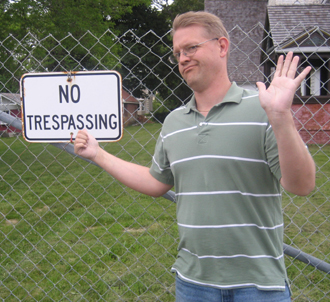 Bob and I had visited Atlantic City, New Jersey on Monday, but we didn’t really get to see a lot of New Jersey until Wednesday and Thursday that week. The morning of Wednesday, June 17, 2009, we had seen the remainder of the sites we need to see in Philadelphia, had lunch in Bristol, Pennsylvania, and then made the short trek to our first destination in Jersey, the capitol building in Trenton. Just as we were arriving at around noon, I got some irritating news from home from Heidi who was feeding my cats. Ashleigh had had friends over after the debacle of my previous trip. This put a bit of a damper on the rest of the day for me.
Bob and I had visited Atlantic City, New Jersey on Monday, but we didn’t really get to see a lot of New Jersey until Wednesday and Thursday that week. The morning of Wednesday, June 17, 2009, we had seen the remainder of the sites we need to see in Philadelphia, had lunch in Bristol, Pennsylvania, and then made the short trek to our first destination in Jersey, the capitol building in Trenton. Just as we were arriving at around noon, I got some irritating news from home from Heidi who was feeding my cats. Ashleigh had had friends over after the debacle of my previous trip. This put a bit of a damper on the rest of the day for me.
Nevertheless, I was happy to be visiting another state capitol, my fourth of the trip, the fifth of the year, and the tenth altogether. This statehouse is the second oldest in the country (after Annapolis) that has been in continuous use. We had an official tour of the capitol, visiting the House and Senate chambers. Unfortunately, distracting me even more was the fact that a mammoth classroom of children were on our tour asking all sorts of stupid question. Even stupider than the ones that Bob and I would normally ask.
The New Jersey State Capitol, the tenth statehouse I’ve visited
Bob and I also got yelled at when we attempted to roam around a bit on our own. It was a far cry from the serenity and casualness of the Delaware capitol in Dover. We were looking to see if there was any sort of tribute to President Cleveland who is both born and buried in the state. We were not-so-politely told that he had been Governor of New York, not New Jersey…so why would they have a tribute honoring him? Okay, but it didn’t stop them from having a tribute to Abraham Lincoln. Whatever.
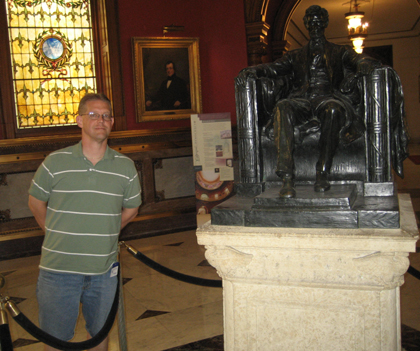
1916 sculpture of Abraham Lincoln by Daniel Chester French, under the capitol dome
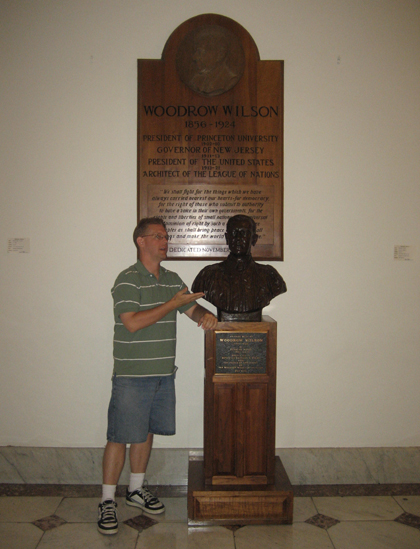
With a bust tribute to Woodrow Wilson, who served as 34th Governor of New Jersey before becoming President of the United States
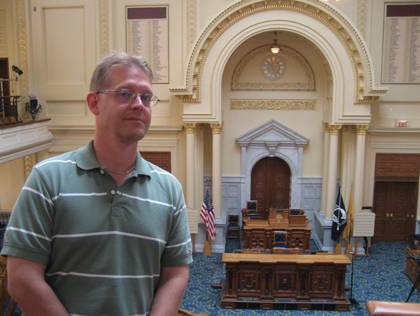
High above the House of Representatives
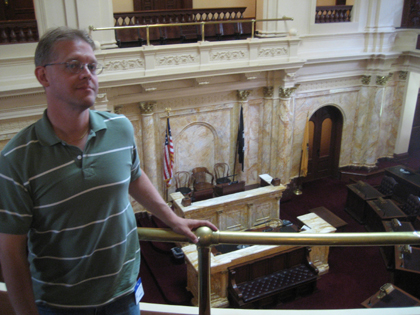
The Senate Chamber
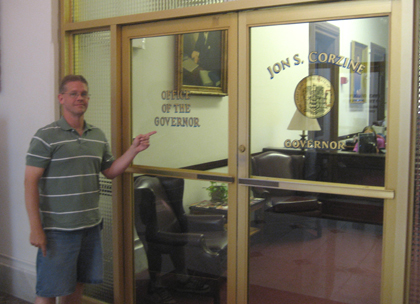
Outside the office of Jon S. Corzine, Governor of New Jersey
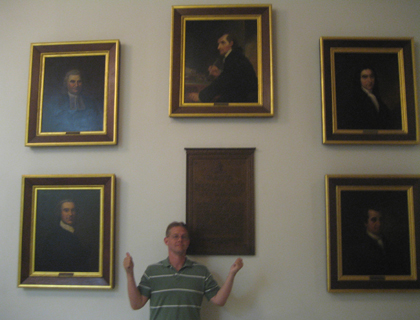
With paintings of the five New Jersey signers of the Declaration of Independence
Bob and I ambled over across the street from the capitol after our tour where there were several other monuments on display, and then headed out for a few other sites in Trenton.
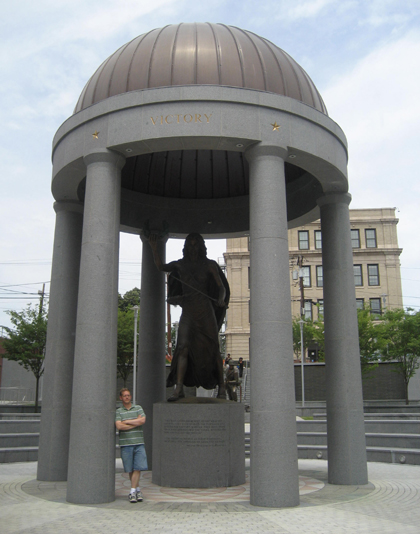
Victory monument across from the New Jersey state capitol
The first was the Friends Burying Ground which housed the final resting place of George Clymer (1739-1813). As one of the first patriots to advocate independence from Britain, Clymer was one of only six men who signed both the Declaration of Independence and the United States Constitution.
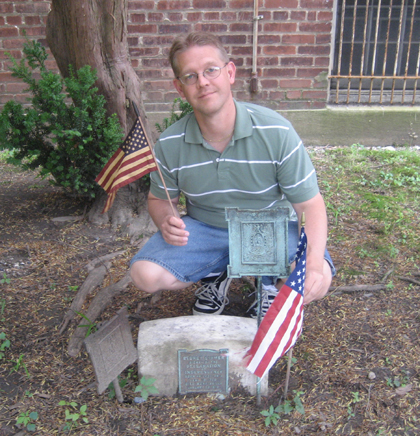
The grave of Declaration of Independence and U.S. Constitution signer George Clymer
In a different cemetery in Trenton was the grave of David Brearley (1745-1790), who had signed the U.S. Constitution on behalf of New Jersey. This was a quite interesting visit. He is interred in the churchyard of Saint Michael’s Episcopal Church. However, there didn’t seem to be any access to the area in which he was located inside the gated yard. My theory was that we had come all of this way to Trenton…where there’s a will there’s a way.
So I found a tiny corridor behind the church that was across from an incredibly run-down flat, with pulsating music, yelling, and perhaps moaning seeping from the walls. It was quite the scene. Still we squeezed down the opening and wound up behind the church where we found an entrance to the fenced-in graveyard. You might say that Bob and I had the courage of our forefathers on this grand day.
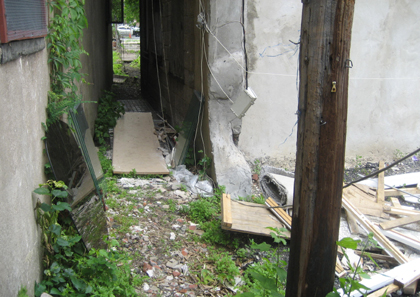
Would you enter this passageway for the grave of a U.S. Constitution signer?
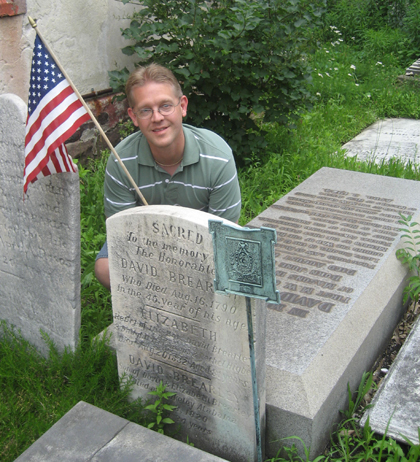
The grave of U.S. Constitution signer David Brearley
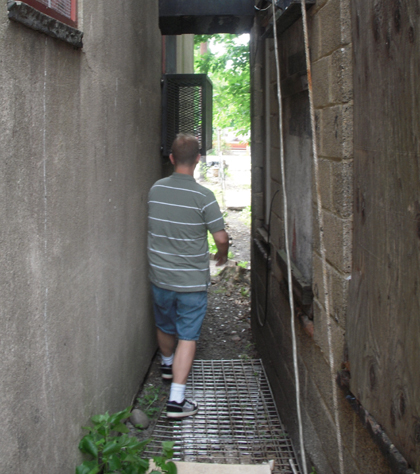
Bidding a hasty retreat from the scariest grave ever
We made one final stop in Trenton to see the William Trent House. Trent was a member of the Pennsylvania Supreme Court and in 1719 he built this house. As houses came up around him, the area became known as Trent Town and then later Trenton. This was a stop that Bob had requested, although I am glad I got to see it. We didn’t tour the inside but just got photos outside of the house.
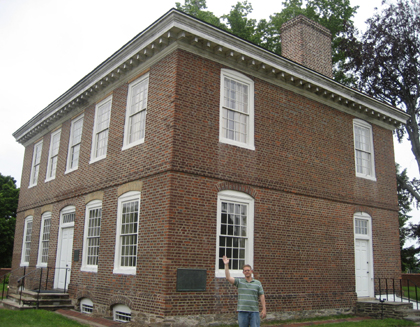
Outside the William Trent house
We bid farewell to Trenton and took a twenty-minute drive to West Windsor and a little community known as Grovers Mill. Oddly enough, nothing had actually happened in this quaint little town. But in 1938, during the radio broadcast debacle of The War of the Worlds, the town of Grovers Mill was where the fictional Martians first landed. Fifty years later, a nice monument was placed in the area, so Bob and I stopped by to see it. And use the port-o-potty.
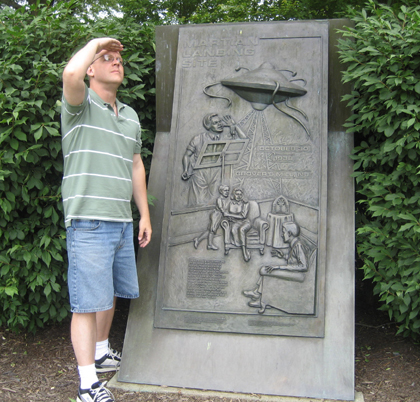
Scouting the Martians in Grovers Mill
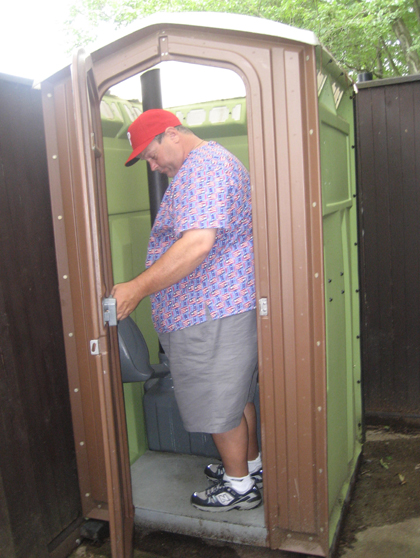
Martians weren’t the only things that landed in Grovers Mill
From there we moved on to Princeton. The Princeton Cemetery had several important graves, the greatest of which was President Grover Cleveland. You can see the further details of our visit to his gravesite here. Interestingly, Bob and I were expecting to find Cleveland in the ‘Presidents Plot’ – but it turns out that this was for Presidents of Princeton College.
Second only to the President, was a grave of Vice President Aaron Burr (1756-1836) – who, because his father was a President at Princeton, was in fact buried in the ‘President’s Plot’. He had served under Thomas Jefferson during his first Presidential term from 1801-1805. Burr was perhaps our nation’s most colorful Vice President, and is remembered today for the duel in which he shot and killed Secretary of the Treasury Alexander Hamilton. In later years, Burr was also charged with treason for a conspiracy in which he would capitalize on a war with Spain.
At the grave of Vice-President Aaron Burr
Just a few feet away from Burr was the grave of John Witherspoon (1723-1794). He was the only active member of the clergy to sign the Declaration of Independence. He was also the president of Princeton College at the time of the signing.
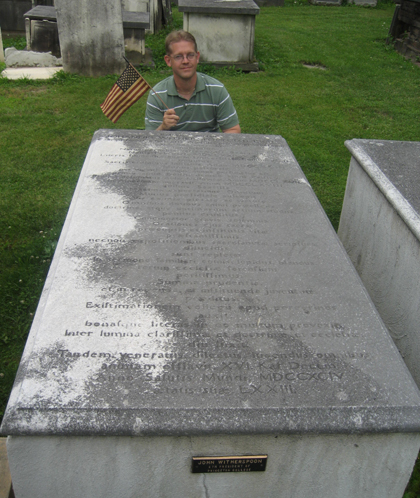
The grave of Declaration of Independence signer John Witherspoon
There were two Presidential houses near the Princeton campus, the Westland home once belonging to Grover Cleveland (who served as a trustee at the college) and two belonging to Woodrow Wilson. Neither were open to the public for tours – but you can see the exteriors by clicking on the Presidents’ names.
Bob and I also walked around the Princeton University campus for a bit, just to check out this ultra-famous college. I resisted the temptation to pose with a real (hot) actual Princeton student and just went ahead and got my picture with a map of the campus.
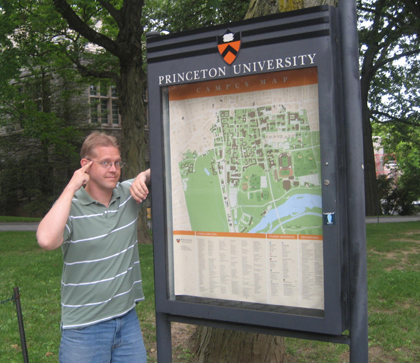
I was smart enough to attend here…just lacked the ambition
There was one final grave to see in Princeton, but it wasn’t in the campus area. It was located in the Stoney Brook Quarter Meeting House burial ground and belonged to Richard Stockton (1730-1781). He was a delegate to the Continental Congress for New Jersey and was another singer of the Declaration of Independence.
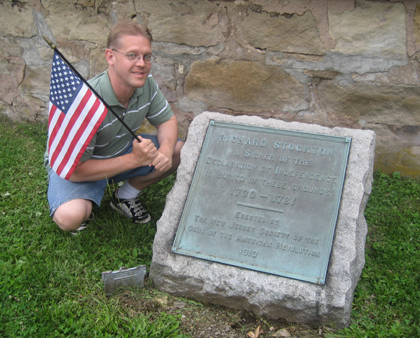
Grave of Declaration of Independence signer Richard Stockton
Just about ten miles away from Princeton is the town of Hopewell, New Jersey. We had just one grave to visit here: that of John Hart (1711-1779) in the First Baptist Church Cemetery. Hart was another delegate from New Jersey to the Continental Congress and a signer of the Declaration of Independence.
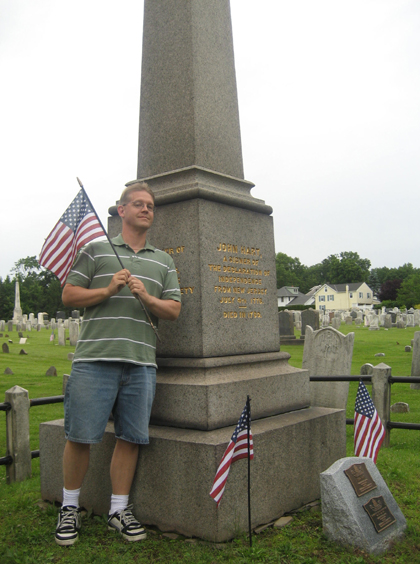
Grave of Declaration of Independence signer John Hart
We left Hopewell around 6pm and headed toward the Jersey shore and the city of Long Branch, located just over an hour away. Bob had balked a little bit about driving all the way out here, but I insisted that this was a must. For starters, it was in Long Branch that President James Garfield had passed away after being shot by an assassin’s bullet in 1881.
Long Branch was known as the ‘Hollywood of the East’ and was frequently visited by United States Presidents. Amazingly, only one structure associated with the Presidents still stands today and that is the former St. James Protestant Episcopal Chapel, now known as the Church of the Presidents. Seven United States Presidents had once worshiped here: Chester A. Arthur, James Garfield, Ulysses S. Grant, Benjamin Harrison, Rutherford B. Hayes, William McKinley, and Woodrow Wilson – all except for Grant while they were currently in office.
Today the church is under major renovation. Also located on the property is Garfield Tea House, a building that was built out of the railroad ties used especially to lay track to bring James Garfield to Long Branch after he had been shot, in hopes that the sea air would possess some healing power.
Unfortunately, the area was all under construction and fenced off. Do I smell a challenge? You can tell by my reaction to the sign at the very top of the posting that this wasn’t going to deter me. I snuck though a hole in the fence so that I could get a (somewhat) decent shot with the Tea House. I’m such a Presidential scofflaw.
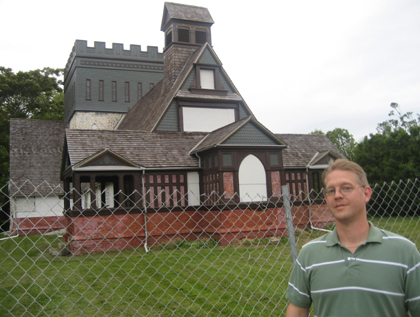
The Church of the Presidents was okay to photograph outside the fence…
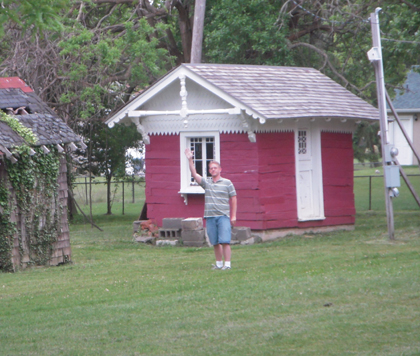
…the Garfield Tea House was not
There was only one problem in visiting the death site of James Garfield and that was that somehow both Bob and I had missed finding the address of the plaque that marked it. So now that we had come all this way, our only option was to do our searching in a local library (calling Mom wasn’t any help, although she tried).
We chose the campus of Monmouth University. It was almost 8pm by this time so we were lucky to find one that was even open. And in another ultimate twist of irony, Bob happened to notice an interesting plaque on the Woodrow Wilson Hall on campus indicating that this particular building, which had been built between 1927 and 1930, sat on the site of Woodrow Wilson’s one-time summer home. Oh, the fates smile brightly down on us at times.
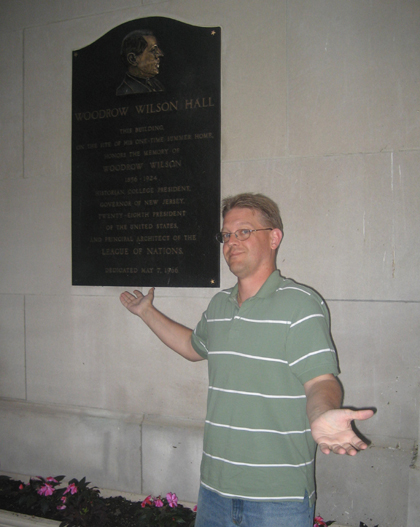
As fate would have it…
I went solo in the library, combing the internet for some very difficult-to-find information which eventually led me to the address of the site in Long Branch where the Garfield plaque sits. Check it out here.
After the long day, there was only one piece of business remaining and that was getting something to eat. We chose the Fuji Japanese Sushi Steak House so that we could get our traditional teppanyaki in. I had the salmon and nice caterpillar roll. Oh, and this was the only time ever that I have had the chef spray sake directly into my mouth. I saw him do this to another customer and honestly believed it was only water – until I got a shot of it. Of course, we needed a second chance so that Bob could get a picture of the event.
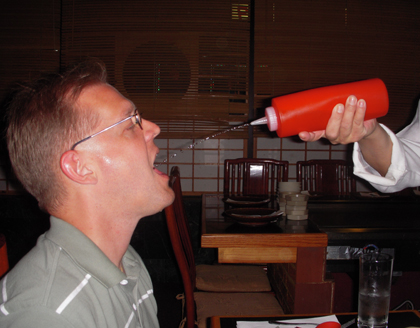
A blast of sake!

Bob and me with our Teppanyaki chef
We started to make our way north, traveling about twenty miles to Hazlet, where we found a Holiday Inn for the night. We would finish up the northern section of New Jersey the next day.
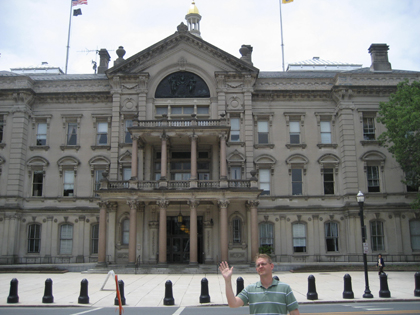
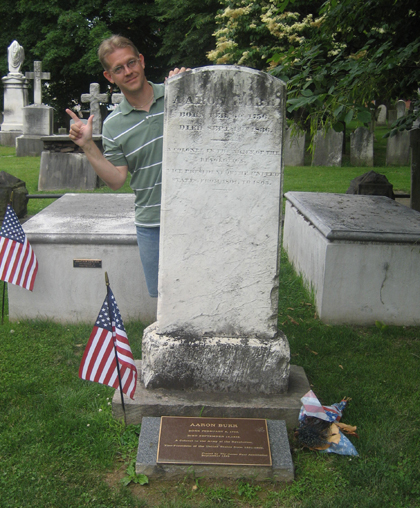
Great post. You’ve seen things in a brief visit that many lifetime residents have never seen or even known about. Too bad you didn’t make it up to Rahway, NJ to see Abraham Clark’s grave. You would’ve had all five Declaration signers.
Well Done!
Michael
December 29th, 2010
Ooops, sorry, I thought you had Hopkinson in there too. I missed that one.
Michael
December 29th, 2010
We got Abraham Clark the next morning in Rahway and had gotten Hopkinson the day before in Philadelphia.
Brad
December 29th, 2010
Great post – I really like reading about your presidential travels. If you’re ever back in central NJ, there’s an interesting and little known site that isn’t too far from the Church of the Presidents. Harding’s mistress Nan Britton gave birth to a daughter in Asbury Park. The house is still standing on Bond Street – you could add it to your Harding page.
Marc
June 11th, 2013
Not to be picky, but the lower chamber located in the State House in Trenton New Jersey, is the General Assembly, not the House of Representatives.
I’m sure by now, that bust of Woodrow Wilson you posed with, is gone from the front foyer. Woody’s desk is also gone from the Governor’s Office. The current Governor — Murphy claims he didn’t know it was Wilson’s desk, even though it has a plaque attached to the front stating that it was Wilson’s desk.
Trochilus
June 30th, 2020